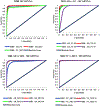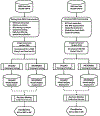MCADNNet: Recognizing Stages of Cognitive Impairment through Efficient Convolutional fMRI and MRI Neural Network Topology Models
- PMID: 32021737
- PMCID: PMC6999050
- DOI: 10.1109/ACCESS.2019.2949577
MCADNNet: Recognizing Stages of Cognitive Impairment through Efficient Convolutional fMRI and MRI Neural Network Topology Models
Abstract
Mild cognitive impairment (MCI) represents the intermediate stage between normal cerebral aging and dementia associated with Alzheimer's disease (AD). Early diagnosis of MCI and AD through artificial intelligence has captured considerable scholarly interest; researchers hope to develop therapies capable of slowing or halting these processes. We developed a state-of-the-art deep learning algorithm based on an optimized convolutional neural network (CNN) topology called MCADNNet that simultaneously recognizes MCI, AD, and normally aging brains in adults over the age of 75 years, using structural and functional magnetic resonance imaging (fMRI) data. Following highly detailed preprocessing, four-dimensional (4D) fMRI and 3D MRI were decomposed to create 2D images using a lossless transformation, which enables maximum preservation of data details. The samples were shuffled and subject-level training and testing datasets were completely independent. The optimized MCADNNet was trained and extracted invariant and hierarchical features through convolutional layers followed by multi-classification in the last layer using a softmax layer. A decision-making algorithm was also designed to stabilize the outcome of the trained models. To measure the performance of classification, the accuracy rates for various pipelines were calculated before and after applying the decision-making algorithm. Accuracy rates of 99.77% 0.36% and 97.5% 1.16% were achieved for MRI and fMRI pipelines, respectively, after applying the decision-making algorithm. In conclusion, a cutting-edge and optimized topology called MCADNNet was designed and preceded a preprocessing pipeline; this was followed by a decision-making step that yielded the highest performance achieved for simultaneous classification of the three cohorts examined.
Keywords: Alzheimer’s disease; Brain; Classification; Deep learning; MCI; Structural and Functional Magnetic Resonance Imaging.
Figures






References
-
- Reisberg B, Ferris SH, Kluger A, Franssen E, Wegiel J, and De Leon MJ, “Mild cognitive (mci): a historical perspective,” International Psychogeriatrics, vol. 20, no. 1, pp. 18–31, 2008. - PubMed
-
- Tampi RR, Tampi DJ, Chandran S, Ghori A, and Durning M, “Mild cognitive: A comprehensive review,” Healthy Aging Research, vol. 4, pp. 1–11, 2015.
-
- Petersen RC, Stevens JC, Ganguli M, Tangalos EG, Cummings J, and DeKosky S, “Practice parameter: early detection of dementia: mild cognitive (an evidence-based review): report of the quality standards subcommittee of the american academy of neurology,” Neurology, vol. 56, no. 9, pp. 1133–1142, 2001. - PubMed
-
- Luck T, Luppa M, Briel S, and Riedel-Heller SG, “Incidence of mild cognitive: a systematic review,” Dementia and geriatric cognitive disorders, vol. 29, no. 2, pp. 164–175, 2010. - PubMed
-
- Jean L, Bergeron M.-v., Thivierge S, and Simard M, “Cognitive intervention programs for individuals with mild cognitive: systematic review of the literature,” The American Journal of Geriatric Psychiatry, vol. 18, no. 4, pp. 281–296, 2010. - PubMed
Grants and funding
LinkOut - more resources
Full Text Sources
